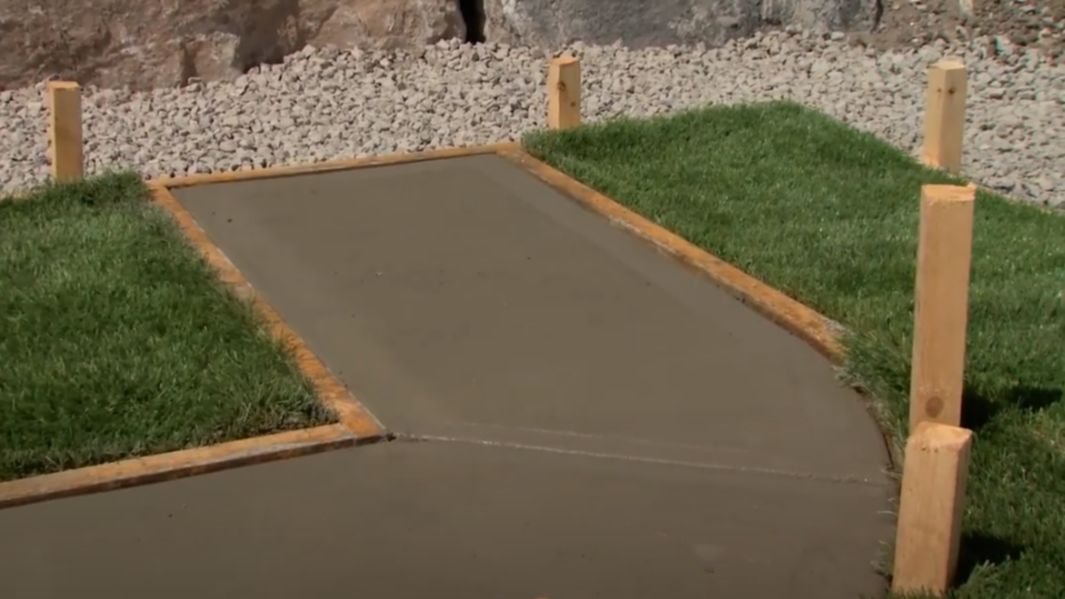Instruction guide and tips for constructing slabs and walks using Sakrete Concrete Mix, Sakrete Fast Set or Sakrete PSI 6000
How to Construct Slabs and Walks
Sakrete offers three, high quality concrete mixes, each providing special benefits for applications 5 cm (2 inches) in thickness or greater. All three products are ideal for constructing slabs, sidewalks, patios, steps, floors and footings,or for setting posts and pales.Just add water.
SAKRETE Concrete Mix: General purpose concrete.
SAKRETE Fast Set: Sets in 30 minutes. Allows for same day use. May be used in cold weather.
SAKRETE PSI 6000: Excellent workability.High strength (42 MPa/6000 psi), reinforced with alkali-resistant fibres to resist cracking and air-entrained for cold weather durability and excellent workability.
PROCEDURES: Mix and substrate temperatures should be maintained between 5 °C (40 °F) and 30 °C (86 °F) for at least 24 hours prior to and 48 hours after. For temperatures below 5 °C (40 °F), refer to SAKRETE Fast Set.
STEP 1: Planning: Position layout stakes so they are aligned with the project borders. Place corner stakes 30 cm (12 inches) outside the finished slab area. Join stakes together with string; the corners should overlap. String lines will show the planned layout and provide the height at which form boards are to be set at.
STEP 2: Excavating: The total depth of the excavation, approximately 13 cm (5 inches) to 15 cm (6 inches), should be determined by allowing for 5 cm (2 inches) minimum of compacted crushed stone under 8 cm (3 inches) to 10 cm (4 inches) of concrete. Excavate 15 cm (6 inches) beyond string lines to allow room for forms. Spread crushed stone evenly throughout the excavation and compact well using a portable vibrator, roller or hand-tamper.
STEP 3: Forming: Using straight 5 cm (2 inch) x 10 cm (4 inch) lumber, cut forms to length, then position so that inside edges are below the string line. Drive pointed 5 cm (2 inch) x 10 cm (4 inch) stakes into the ground at 1 m (3 ft) spacing, to support forms. Screw together all forms, braces and corners from outside the work area. NOTE: Adjust forms before securing to direct rainwater run-off. Slope approximately 3 mm (1/8 inch) per 305 mm (1 ft).
STEP 4: Curving: Create curves by attaching 3 mm (1/8inch) hardboard to the inside corners of forms. Drive support stakes behind the curved form. Place expansion joint board against adjoining surfaces to allow for independent movement. Treat the insides of the forms with a commercial release-agent or vegetable oil prior to pouring.
STEP 5: Placing: After mixing the concrete, place and consolidate inside the forms, slightly overfilling and roughly levelling. Work a pointed trowel along the inside edges of the forms, removing trapped air pockets. Tap the forms with a hammer for smoother sides. NOTE: Mixing, placing and finishing should be timed to make sure that concrete does not harden before finishing.
STEP 6: Leveling: Level concrete, moving a straight-edged board (overlapping the forms) in a sawing motion across concrete, removing any excess and filling low areas. Then float the concrete smooth using a wood, magnesium or aluminum float trowel. Stop floating when bleed water accumulates on the surface.
STEP 7: Finishing: After bleed water evapourates, finish as desired. lt is recommended, especially for air-entrained concrete (i.e.SAKRETE PSI 6000), to use a wood, magnesium or aluminum float trowel for a smooth surface. For a textured surface, use a broom or brush. Use an edger tool to finish edges. NOTE: Finishing cementitious materials too early or overworking the material can cause dusting, cracking, scaling and a weak surface.
STEP 8: Jointing: Stress contrai joints are placed to contrai where slabs crack, along a pre-determined path. Use either a hand jointer while the mix is soit, or saw-cut 6 to 18 hours after hardening. The joint should be 1/5 of the full thickness of the slab and be placed every 2.4 m (8 ft) in both directions. Adjust down for appearances (centering).
STEP 9: Curing: Curing means maintaining proper moisture and temperature. Allow newly placed material to set until surface is hard to the touch. Keep material damp or caver with plastic to prevent evaporation of mix water for at least three (3) days. Protect freezing for at least 24 hours.
Download PDF instructions
Tips for constructing slabs and walks:
- Prepare layout.
- Adjust forms to direct water run-off.
- Screw stakes to forms.
- Oil forms for easy release.
- Avoid a soupy mix.
- Do not over trowel.
- Place stress contral joints.
- Cure properly.
- Wear proper safety equipment (i.e. safety glasses, gloves, etc.).


